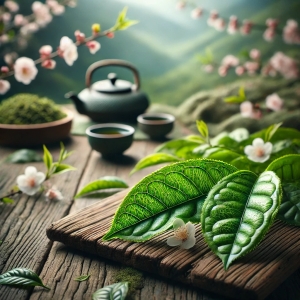Exploring Huangshan Maofeng Tea and Taiping Houkui in Anime and LiteraturePosted by chasourcing on August 5th, 2024  Introduction Tea, a central theme in many cultural narratives, often transcends its role as a mere beverage to symbolize deeper themes of tranquility, tradition, and nature. In this exploration, we delve into two prestigious Chinese teas, Huangshan Maofeng and Taiping Houkui, as depicted in anime and literature. These teas are not only prized for their exquisite flavors but also for their rich cultural heritage, which is often woven into various forms of popular culture. Huangshan Maofeng Tea in Popular Media Huangshan Maofeng Tea, a renowned green tea from the Yellow Mountains of China, is celebrated for its delicate flavor and aromatic freshness. Its cultivation in the misty peaks of Huangshan, where the tea bushes are often enveloped in fog, provides a picturesque backdrop ideal for storytelling in anime and literature. This tea is frequently associated with purity and renewal, themes that are prevalent in springtime narratives. In anime such as "Mushishi," where the natural world plays a pivotal role in the storyline, Huangshan Maofeng could be seen as a healing elixir that the protagonist uses to soothe characters’ ailments, symbolizing nature's gentle touch. Similarly, in literary works, this tea often appears during scenes of introspection or significant life changes, representing clarity and calmness. Taiping Houkui in Cultural Narratives Taiping Houkui, a unique green tea from the Taiping region, is known for its large, flat leaves which are said to resemble monkey paws. The meticulous process of producing Taiping Houkui, which involves hand-flattening the leaves under high temperatures, highlights themes of craftsmanship and tradition. These themes are beautifully integrated into stories that celebrate human ingenuity and the artistry of traditional practices. In the world of anime, Taiping Houkui might be featured in a setting like that of "Barakamon," where the protagonist retreats to a rural village to rediscover his artistic passion. Here, the tea serves as a metaphor for the protagonist's journey, its preparation mirroring the careful and deliberate strokes of a calligrapher's brush. In literature, Taiping Houkui could be used to bridge generations, with characters sharing a pot of this tea as they exchange stories of the past, thus preserving their heritage. Symbolism and Thematic Representation Both Huangshan Maofeng and Taiping Houkui carry profound symbolic meanings in their narratives. Huangshan Maofeng is often a symbol of the ethereal and transient nature of beauty, its delicate leaves and mild flavor evoking the fleeting moments of life’s joys and sorrows. On the other hand, Taiping Houkui, with its robust leaves and strong roots in traditional culture, symbolizes endurance and the strength derived from cultural continuity. Consumer Engagement and Global Reach As these teas are featured in popular media, they naturally attract a global audience, which becomes curious about their origins and the stories behind them. Fans of anime and readers of literature who encounter these teas often seek them out, eager to experience the flavors that are so intricately described in their favorite stories. This not only boosts global appreciation for these teas but also fosters a deeper understanding of Chinese tea culture. Conclusion Through their portrayals in anime and literature, Huangshan Maofeng and Taiping Houkui transcend their roles as mere beverages to become storied elements rich with cultural significance. These narratives not only highlight the sensory pleasures of the teas but also their cultural, historical, and symbolic importances. As elements within broader cultural narratives, these teas offer audiences around the world a taste of the philosophical and aesthetic pleasures that traditional Chinese teas can offer. Like it? Share it!More by this author |


